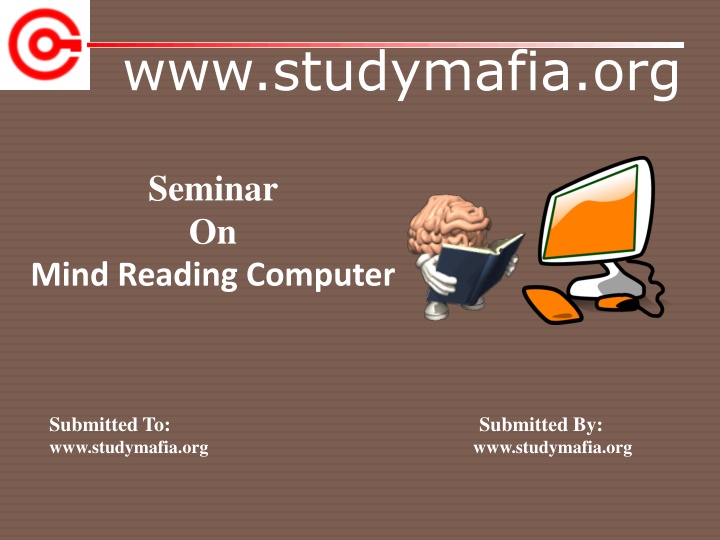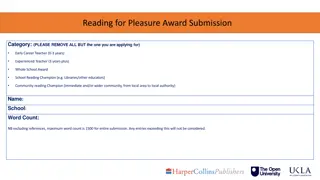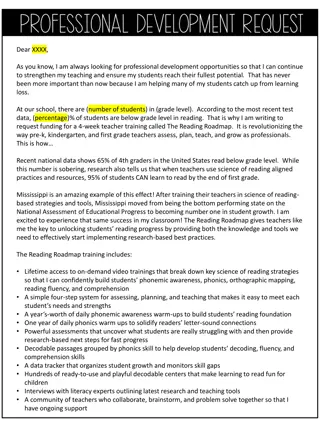
Innovative Seminar on Mind Reading Computer
Explore the fascinating world of mind-reading technology through this comprehensive seminar on how computers can infer mental states using facial signals. Discover the principle, applications, advantages, and challenges of mind reading, and learn about the cutting-edge techniques and technologies involved. Dive into the future possibilities of mind-reading computers enhancing human-computer interaction and revolutionizing various industries.
Download Presentation

Please find below an Image/Link to download the presentation.
The content on the website is provided AS IS for your information and personal use only. It may not be sold, licensed, or shared on other websites without obtaining consent from the author. If you encounter any issues during the download, it is possible that the publisher has removed the file from their server.
You are allowed to download the files provided on this website for personal or commercial use, subject to the condition that they are used lawfully. All files are the property of their respective owners.
The content on the website is provided AS IS for your information and personal use only. It may not be sold, licensed, or shared on other websites without obtaining consent from the author.
E N D
Presentation Transcript
www.studymafia.org Seminar On Mind Reading Computer Submitted To: www.studymafia.org www.studymafia.org Submitted By:
Content Introduction Principle of Mind Reading Why Mind Reading How does it Work Techniques Application Advantages Disadvantages Conclusion
Introduction People express their mental states, including emotions, thoughts, and desires, all the time through facial expressions, vocal nuances and gestures. This is true even when they are interacting with machines. Our mental states shape the decisions that we make, govern how we communicate with others, and affect our performance. The ability to attribute mental states to others from their behavior and to use that knowledge to guide our own actions and predict those of others is known as theory of mind or mind-reading.
Principle of Mind Reading A computational model of mind-reading Drawing inspiration from psychology, computer vision and machine learning, the team in the Computer Laboratory at the University of Cambridge has developed mind-reading machines computers that implement a computational model of mind-reading to infer mental states of people from their facial signals. The goal is to enhance human-computer interaction through empathic responses, to improve the productivity of the user and to enable applications to initiate interactions with and on behalf of the user, without waiting for explicit input from that user. There are difficult challenges:
Why mind reading The mind-reading computer system presents information about your mental state as easily as a keyboard and mouse present text and commands. Imagine a future where we are surrounded with mobile phones, cars and online services that can read our minds and react to our moods. How would that change our use of technology and our lives? We are working with a major car manufacturer to implement this system in cars to detect driver mental states such as drowsiness, distraction and anger. Current projects in Cambridge are considering further inputs such as body posture and gestures to improve the inference. We can then use the same models to control the animation of cartoon avatars. We are also looking at the use of mind-reading to support on-line shopping and learning systems.
How does it work? The mind reading actually involves measuring the volume and oxygen level of the blood around the subject's brain, using technology called functional near-infrared spectroscopy (fNIRS). The user wears a sort of futuristic headband that sends light in that spectrum into the tissues of the head where it is absorbed by active, blood-filled tissues. The headband then measures how much light was not absorbed, letting the computer gauge the metabolic demands that the brain is making. The results are often compared to an MRI, but can be gathered with lightweight, non-invasive equipment.
Web search For the first test of the sensors, scientists trained the software program to recognize six words - including "go", "left" and "right" - and 10 numbers. Participants hooked up to the sensors silently said the words to themselves and the software correctly picked up the signals 92 per cent of the time. Then researchers put the letters of the alphabet into a matrix with each column and row labeled with a single-digit number. In that way, each letter was represented by a unique pair of number co-ordinates. These were used to silently spell "NASA" into a web search engine using the program.
Techniques Facial Affect Detection It is done using hidden Markov Model, Neural Network processing or active appearance model. Emotional Classification Classification by Paul Ekman Anger, Fear, Happiness,Disgust ,Sadness, Surprise.
Techniques.. Facial Electromyography It is used to measure the electrical activity of the facial muscles. Muscles used are corrugator supercilii muscle and others. Galvanic Skin Response It is a measure of skin conductivity, which is dependent on how moist the skin is. Blood Volume Pulse It is measured by a process called photoplethysmography. It produces a graph indicating blood flow through the extremities.
Algorithm LDA, k-NN, GMM, SVM, Decision Tree Algorithm. LDA (Linear Discriminant Analysis):- 1. Used in statistics , pattern recognition and machine learning to find a linear combination of features. 2. LDA is closely related to regression analysis. 3. Few mathematical methods like-Probability Density Function , Co-variance and mean for 2-class data.
Databases Data recorded has to be matched with subject s data. First data base was created FAU Aibo Emotion Corpus for CEICES (Combining Efforts for Improving Automatic Classification of Emotional User States).
Applications Prediction of Bankruptcy. Facial recognition. Marketing. Knows what the Eye can see. Converts Thoughts into Speech. Can be used for Sting Operations. Help Paralytic Patients.
Advantages and uses This prototype mind-controlled wheelchair developed from the University of Electro-Communications in Japan lets you feel like half Professor X and half Stephen Hawking except with the theoretical physics skills of the former and the telekinetic skills of the latter. A little different from the Brain-Computer Typing machine, this thing works by mapping brain waves when you think about moving left, right, forward or back, and then assigns that to a wheelchair command of actually moving left, right, forward or back. The sensors have already been used to do simple web searches and may one day help space-walking astronauts and people who cannot talk. The system could send commands to rovers on other planets, help injured astronauts control machines, or aid disabled people.
Advantages and uses In everyday life, they could even be used to communicate on the sly - people could use them on crowded buses without being overheard The finding raises issues about the application of such tools for screening suspected terrorists -- as well as for predicting future dangerousness more generally. We are closer than ever to the crime-prediction technology of Minority Report.
Disadvantages and problems Tapping Brains for Future Crimes Looking at scientific advances like these, legal scholars are beginning to question the foundational principles of our criminal justice system. For example, University of Florida law professor Christopher Slobogin, who is visiting at Stanford this year, has set forth a compelling case for putting prevention before retribution in criminal justice. It's a tempting thought. If there is no such thing as free will, then a system that punishes transgressive behavior as a matter of moral condemnation does not make a lot of sense. It's compelling to contemplate a system that manages and reduces the risk of criminal behavior in the first place.
Disadvantages and problems We aren't particularly good at rehabilitation, either, so even if we were sufficiently accurate in identifying future offenders, we wouldn't really know what to do with them. Nor is society ready to deal with the ethical and practical problems posed by a system that classifies and categorizes people based on oxygen flow, genetics and environmental factors that are correlated as much with poverty as with future criminality. In time, neuroscience may produce reliable behavior predictions. But until then, we should take the lessons of science fiction to heart when deciding how to use new predictive techniques. The preliminary tests may have been successful because of the short lengths of the words and suggests the test be repeated on many different people to test the sensors work on everyone.
Conclusion Tufts University researchers have begun a three-year research project which, if successful, will allow computers to respond to the brain activity of the computer's user. Users wear futuristic-looking headbands to shine light on their foreheads, and then perform a series of increasingly difficult tasks while the device reads what parts of the brain are absorbing the light. That info is then transferred to the computer, and from there the computer can adjust it's interface and functions to each individual. One professor used the following example of a real world use: "If it knew which air traffic controllers were overloaded, the next incoming plane could be assigned to another controller." Hence if we get 100% accuracy these computers may find various applications in many fields of electronics where we have very less time to react.
References www.eurescom.de/message/default_Dec2004.asp blog.marcelotoledo.org/2007/10 www.newscientist.com/article/dn4795-nasa-develops- mindreading-system http://blogs.vnunet.com/app/trackback/95409 www.studymafia.org

![[PDF⚡READ❤ONLINE] Zen Mind, Beginner's Mind: 50th Anniversary Edition](/thumb/20459/pdf-read-online-zen-mind-beginner-s-mind-50th-anniversary-edition.jpg)




















